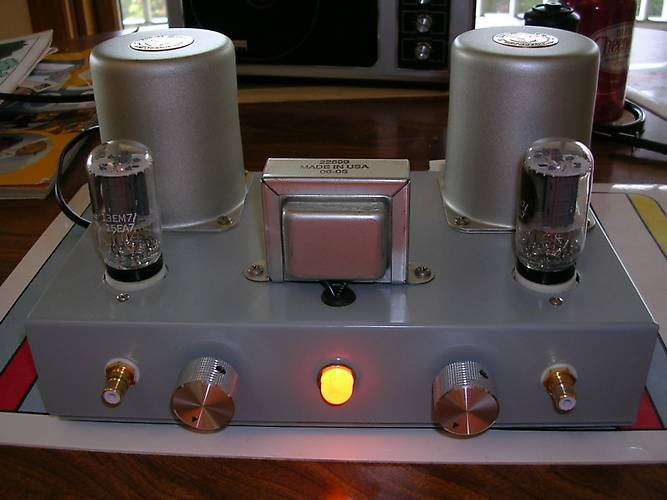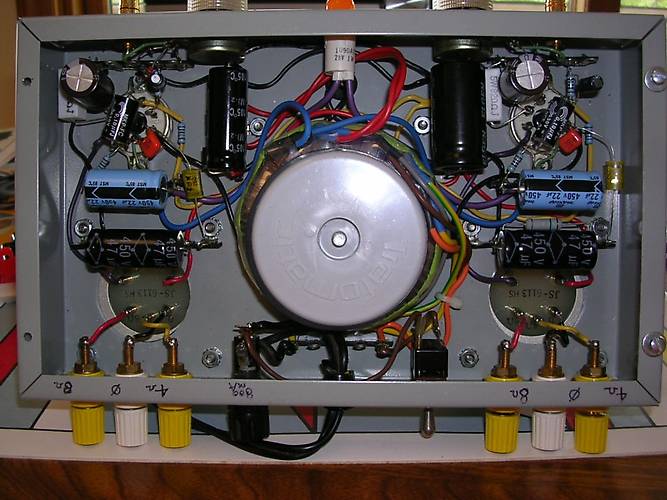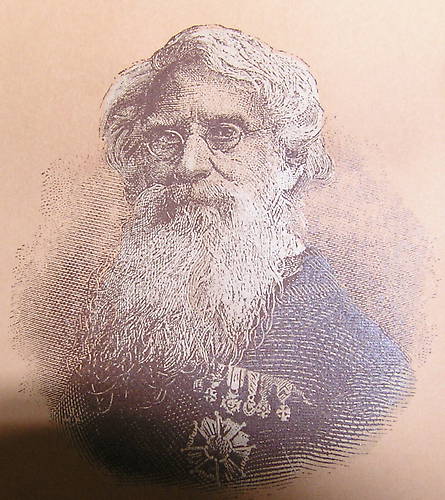There is now a possibly good alternative low-cost toroidal power transformer for this design, from An-Tek.. It is the 50VA rated 05T200, which has two 115V primaries, one HV secondary with 200VAC (and tapped at 180VAC) @ 150 mA, and two 6.3V, @ 2A filament windings.

The filament windings could be connected in series for using 13EM7s, or used for feeding the two separate 6EM7 filaments. THis trannie also has sufficient VA capability to power up a stereo PP 6EM7 or 13EM7 amp.
The 05T200 costs $25, plus $5 shipping, and these have appeared on johnango's e-bay listings, though not yet on teh AnTEk product listings..
Dimensions are 3.7 inches diameter X 1.6 inches height, so it can be mounted under a standard 2 inch deep chassis.
Update 6-Aug-2010:
I received two of these trannies today, and since the 6.3VAC windings are teh outermost windings, it was easy to count the turns, and both have 47 turns, for 6.3V which works out to 7 1/2 turns per volt. Since, with a toroid, there is no such thing as a "half turn, let's just call it 15 turns for 2VAC. Should be pretty easy to add an extra winding, if needed.
I think that the next incarnation of "Lucky thirteen" wmay use 6FD7s, as these trannies may be a good PSU match, and I have about a dozen 6FD7s looking for "gainful" employment. I suppose that to stick with the theme, 13FD7s could be used... I've already worked up circuits for "spud" SET and for SRPP, PSET using 2 tubes per channel. A few simple changes, and this could also be PP.
Update 7-Aug-2010:
I performed some operational tests using the 200VAC output on these transformers, using a FWB rectifier and 140 uF (40 uF and 100 uF cap in parallel, I've used this same setup for testing other trannies).
It does fall somewhat short of producing the optimum B+ voltage ( approx 270-280 VDC) for the 6EM7 / 13EM7 /6 6FD7 spud amps, by about 24VDC, under a 74 mA DC test load. But, a few resistor and OPT primary impedance adjustments should make up for this.
I loaded the DC voltage, progressively with 10K, 10W WW resistors, adding one at a time in parallel, and with 1.2 amp filament loads (6AV5GAs) on each of the two 6.3VAC filament windings, and then recorded the following results:
No load: 280VDC @ 0 mA (200VAC secondary)
10K load: 263VDC @ 26.3 mA
5K load: 255VDC @ 51 ma
3.33K load: 246VDC @ 74 mA
2.5K load: 238VDC @ 95 mA
2.0K load: 232VDC @ 116 mA
And then, for the "killer test":
40W, 230V lightbulb: 222VDC @ 175 mA (exceeds current ratings)
This
will work with the 6/13EM7 spud amps, but at a somewhat reduced output power level. Perhaps using a lower Z OPT primary of 3.5 to 4.3K, and a lower value cathode resistor (680 ohms, 5W) may compensate for the reduced B+ voltages. Time for some more calculations...
Update 22-Aug-2010:
However..... If one were to use fixed bias, with approx -30V on the power triode's grid, then these B+ voltages would be near ideal. This voltage could be generated from the series connected filament windings, and a simple voltage doubler circuit, much as is done in Fred Nachbaur's SET design. Or perhaps a hybrid combination of cathode and fixed bias, perhaps using a 200 ohm cathode resistor and -23 to -25VDC grid bias, or some related scheme.
The 05T200 is almost ideal for use with Darling and 12B4SE amp designs, though it is a bit of an overkill. And probably just about perfect for 1626 or 12B4A PSET or PP designs. I have used this with very good results in a small 12B4A SET, built into a cast aluminum box, details and photos are posted elsewhere.
Updated update to the earlier updates:
An-Tek now has the 05T240, which has the HV secondary with 220VAC and 240VAC, which puts it in the "sweet spot" for 6EM7s, 6FD7s, 13EM7s, 6GF7s, etc. Other than having a 20 & 40VAC higher voltage secondary, everything else is similar to the 05T200.
/ed B






 in the process.
in the process.




 With the 13EM7's nominal 750 ohm plare resistance, I figured I could get away with using lower impedance plate loading than the standard 5K primary OPT. Might have to try 3K on the next go-round
With the 13EM7's nominal 750 ohm plare resistance, I figured I could get away with using lower impedance plate loading than the standard 5K primary OPT. Might have to try 3K on the next go-round 



